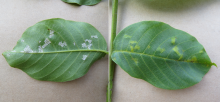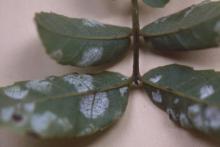Cause The fungus Microstroma juglandis is widespread in western production areas. The disease is more common in wet years and in orchards with poor air circulation. Hyphae of the fungus emerge from stomata, especially along veins and produce white masses of spores.
Symptoms Lesions are soft to bright yellow on the upper surface and angular following leaf veins. The corresponding areas on the undersurface are chalky white where the fungus is sporulating. Lesions become necrotic with age and may coalesce causing the leaf to turn brown and dry. Infection of young leaves may be distorted. Rarely symptoms on fruit may be seen as small, circular downy area on the hull. The lesion grows as the fruit grows. The edge may be downy at first but then turns dark brown to black. The result is a wide dark circle with a lighter green center with a sunken margin.
Control Seldom needed as the incidence is low in orchards treated frequently with copper-based bactericides for blight control.
Reference Teviotdale, B.T., Michailides, T.J., and Pscheidt, J.W. 2002. Compendium of nut crop diseases in temperate zones. St. Paul, MN:APS Press.



